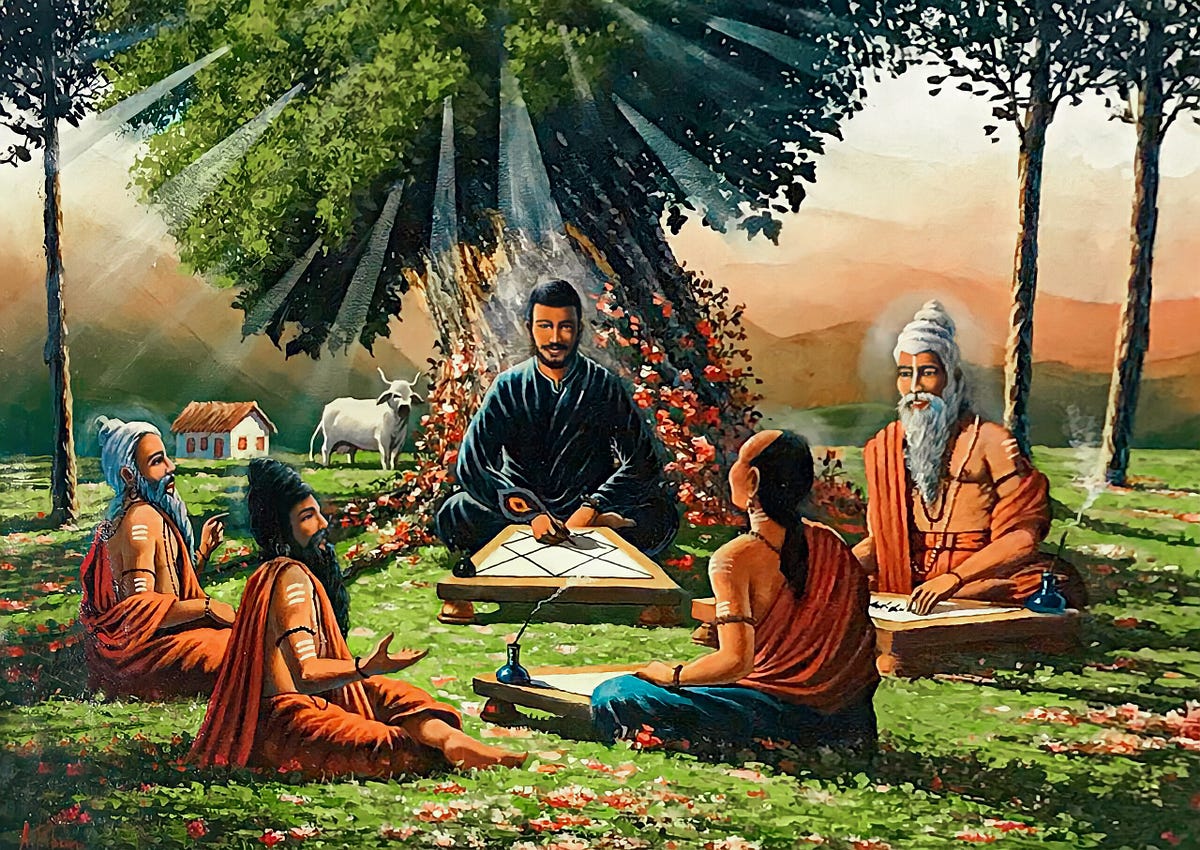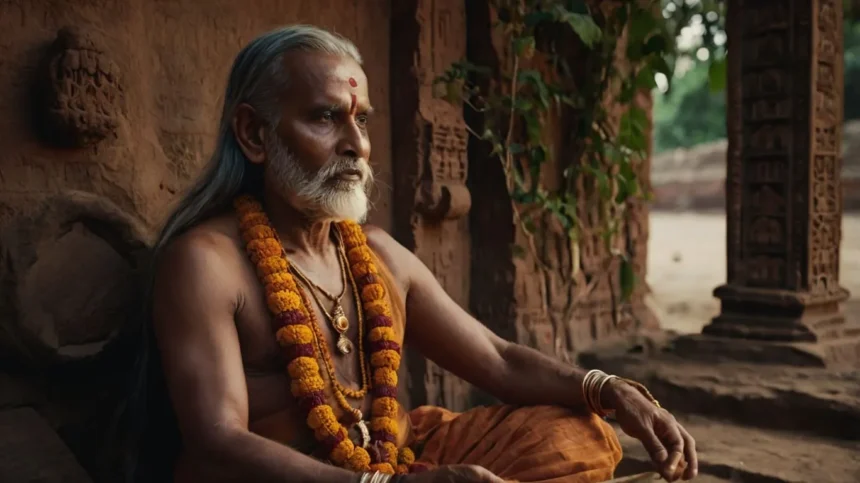The Vedic Age (1500 BCE – 600 BCE) marks a significant chapter in Indian history, bridging the gap between the decline of the Indus Valley Civilization and the emergence of structured kingdoms. This era laid the foundation for Indian culture, religion, and philosophy, with the creation of the Vedas—sacred texts that defined the spiritual and societal framework of the time.
The Vedic Age stands as the bedrock of Indian civilization, where the spiritual, cultural, and philosophical foundations were laid.
Swami Vivekananda, influential spiritual leader and philosopher.
The Vedic Age saw a transition from the pastoral lifestyle of the Early Vedic period to structured agrarian societies during the Later Ancient Indian Philosophy. The creation of the Vedas, along with texts like the Upanishads, laid the foundation for Hindu philosophy and spirituality. Politically, tribal leadership evolved into monarchies, while the Varna system began shaping societal roles. Advancements in agriculture, trade, and metallurgy further strengthened the economic and social fabric, paving the way for future Indian empires and cultural traditions.
Origins of the Vedic Age
The term Veda translates to “superior knowledge” in Sanskrit. Composed by sages like Ved Vyasa, the Vedas provide insight into this era, often divided into two phases:

- Early Vedic Period (1500 BCE – 1000 BCE)
- Later Vedic Period (1000 BCE – 600 BCE)
The Aryans, pastoral nomads speaking Indo-Aryan languages, migrated into the Indian subcontinent during this period. Their rural lifestyle, contrasting the urban culture of the Harappans, gave rise to a society deeply rooted in agriculture, rituals, and oral traditions. Scholars like Max Muller and Bal Gangadhar Tilak have debated the origins of the Aryans, proposing Central Asia and the Arctic region, respectively, as their homeland.
Vedic Literature: The Pillars of Knowledge
The Ancient Indian Philosophy, regarded as Aparusheya (not man-made but divinely inspired), forms the foundation of Hindu philosophy and culture. It consists of four primary texts and their associated components, each serving unique purposes and encapsulating vast knowledge about religion, rituals, and life philosophy.
The Four Vedas
- Rig Veda:
- The oldest Ancient Indian Philosophy, comprising 1,028 hymns (Suktas) in ten books (Mandalas).
- Dedicated to deities like Indra (Rain), Agni (Fire), and Soma (Divine Nectar), it reflects a pastoral and nature-centric worldview.
- Philosophical hymns like the Nasadiya Sukta explore existential questions such as the origin of the universe, raising profound thoughts like “Do even the gods know the truth of creation?.
- Sama Veda:
- Known as the “Veda of Melodies,” it consists of 1,549 verses, most derived from the Rig Veda, designed to be sung during rituals.
- Its chants form the foundation of Indian classical music and are integral to public worship. The Chandogya Upanishad, part of this Veda, explores space, time, and spiritual connections.
- Yajur Veda:
- A collection of sacrificial prayers in prose and poetry, divided into Shukla (White) and Krishna (Black) branches.
- Detailed instructions on rituals like Rajasuya (coronation ceremony) and Ashvamedha (horse sacrifice) emphasize its role in royal and public ceremonies.
- Atharva Veda:
- A mix of spiritual and practical knowledge, focusing on charms, spells, and daily life rituals.
- Highlights healing practices, societal harmony, and metaphysical insights, bridging the mystical with the mundane.
Supplementary Texts
- Brahmanas: Prose texts explaining the hymns, rituals, and the symbolism behind sacrifices. For instance, the Shatapatha Brahmana of Yajur Veda discusses the concept of rebirth and ploughing rituals.
- Aranyakas: Philosophical forest texts focusing on meditation and the inner meanings of rituals. These reflect a transition from ritualistic to spiritual interpretations of life.
- Upanishads: Known as Vedanta (end of the Vedas), these explore metaphysical concepts such as the nature of the soul (Atman), cosmic truth (Brahman), and the meaning of existence. Famous examples include the Mundaka Upanishad (Satyameva Jayate motto) and the Isha Upanishad.
Legacy and Influence
Ancient Indian Philosophy has profoundly shaped Hindu practices, philosophy, and society. Its principles underpin yoga, meditation, music, and governance. The philosophical depth and universality of the Upanishads have influenced global thought, inspiring figures like Swami Vivekananda and modern intellectuals.
For further exploration, visit resources like Temple Purohit or Byju’s History Notes to dive deeper into Vedic heritage. Lude the Upanishads (philosophical treatises), Brahmanas (ritual instructions), Aranyakas (forest texts), and the epics Ramayana and Mahabharata, which continue to influence Indian culture.
Society and Culture
The Early Ancient Indian Philosophy (1500 BCE – 1000 BCE) was marked by a relatively simple, egalitarian social and cultural structure, rooted in pastoralism and evolving towards agricultural settlements. This era laid the foundational framework for Indian society, religion, and economy.

Social Structure
- Patriarchal System: The family was led by the father (kulapa), but women had considerable freedom and respect. They could participate in intellectual and spiritual pursuits, exemplified by female sages like Lopamudra and Apala, who contributed to Rigvedic hymns.
- Egalitarianism: Social divisions were not rigid, and there was fluidity in roles based on skill and contribution. The absence of a structured caste system allowed for a more inclusive society.
- Role of Women: Women could attend assemblies (Sabha and Samiti), receive education, and choose their spouses through Swayamvara. This contrasts with the more restrictive practices of later periods.
Economic Life
- Pastoralism: Cattle were central to the economy, serving as a symbol of wealth and a medium of exchange. Herding was a vital occupation.
- Agriculture: Gradually, the society transitioned to cultivating crops like barley and wheat, aided by the use of plows and irrigation systems. This shift marked the beginning of settled life.
- Trade and Barter: Transactions were initially conducted through a barter system, involving goods like cattle, grains, and ornaments. Later, gold coins called Nishka began to be used, especially in larger trade deals.
Religion
- Personification of Nature: Deities were associated with natural forces, reflecting the people’s dependence on the environment. Important gods included:
- Indra: Representing rain and thunder, vital for agriculture.
- Agni: The intermediary between humans and gods through sacrificial fire.
- Varuna: The upholder of cosmic order and moral law.
- Simple Rituals: Worship involved offerings and chanting hymns without the construction of temples or use of idols, emphasizing a direct connection with nature and the divine.
The Early Vedic society’s emphasis on fluid social roles, pastoral wealth, and nature-based spirituality reflects its adaptability and resilience. Its cultural and economic shifts sowed the seeds for more complex societal structures in the Later Ancient Indian Philosophy.
Later Vedic Period
- Social Evolution:
- The Varna system (fourfold caste system) solidified, with roles defined for Brahmins, Kshatriyas, Vaishyas, and Shudras.
- Women’s status declined, with fewer opportunities for intellectual growth.
The Later Vedic period saw the firm establishment of the Varna system, marking a shift towards social rigidity and a decline in women’s intellectual freedom.
Dr. B.R. Ambedkar
- Economy:
- Advanced agricultural techniques introduced crops like rice.
- Iron tools facilitated industrial growth in pottery, leatherwork, and carpentry.
- Trade flourished, with connections to Mesopotamia and Babylon.
- Religion:
- Shifted from nature worship to ritualistic practices. Gods like Vishnu and Rudra gained prominence.
- Elaborate sacrifices like Ashvamedha and Rajasuya reflected royal authority.
- Growing dissatisfaction with priestly dominance set the stage for Buddhism and Jainism.
Political Organization
- Early Vedic Period:
- Organized into tribes (Janas), led by chiefs (Rajan), elected based on ability.
- Councils like Sabha (elders) and Samiti (general assembly) played key roles.
- Later Vedic Period:
- Tribal groups merged into larger territorial states (Janapadas).
- Kingship became hereditary, with rituals enhancing divine status.
Philosophy and Science
The Ancient Indian Philosophy marks the dawn of Indian philosophy, laying the groundwork for metaphysical and scientific thought. The Upanishads, pivotal texts of this era, shifted focus from ritualistic practices to exploring profound questions about existence, reality, and consciousness. Concepts like Brahman (the ultimate reality) and Atman (the individual soul) became central themes, encapsulated in teachings like “Tat Tvam Asi” (That Thou Art), which unify the self with the cosmos.

Philosophical Contributions
- Brahman and Atman: The Upanishads describe Brahman as eternal, infinite, and beyond sensory perception. Atman, the inner essence of individuals, is ultimately one with Brahman, promoting a philosophy of non-duality (Advaita).
- Karma and Moksha: The concepts of karma (action and consequence) and moksha (liberation from the cycle of rebirth) emerged, forming the ethical and spiritual basis for Hinduism and influencing later Indian religions like Buddhism and Jainism.
- Unity in Diversity: Philosophies emphasized interconnectedness, fostering compassion and universal understanding. The Chandogya Upanishad uses metaphors like rivers merging into the ocean to illustrate this unity.
Scientific Insights
- Astronomy: Texts like Vedanga Jyotisha provided the earliest frameworks for timekeeping and calendars. They emphasized lunar and solar cycles for organizing rituals and agricultural practices.
- Quantum Parallels: The omnipresence and interconnectedness of Brahman resonate with modern concepts like quantum entanglement, highlighting unity in diversity across space and time.
- Consciousness Studies: The Upanishadic view of consciousness as intrinsic to reality parallels modern neuroscience’s quest to understand subjective experience.
Key Texts and Stories
- The Brihadaranyaka Upanishad explores the self and liberation through a dialogue between sage Yajnavalkya and Maitreyi, delving into the impermanence of material wealth compared to spiritual knowledge.
- The Katha Upanishad narrates a dialogue between Nachiketa and Yama (Lord of Death) on the nature of the soul, immortality, and the path to enlightenment.
Enduring Influence
The Ancient Indian Philosophy and scientific contributions have profoundly shaped Indian thought. The emphasis on meditation, ethical living, and the quest for ultimate truth continues to inspire modern spirituality and inquiry into the nature of existence.
For a deeper dive, explore resources like Britannica and Philosophy of Nature.
Impact and Legacy
The Ancient Indian Philosophy defined the socio-religious fabric of India, influencing governance, societal norms, and cultural practices. Its literature and philosophy continue to shape global thought, while the rituals and traditions are integral to Indian spirituality.
Thought-Provoking Questions
- How did the transition from egalitarianism to caste-based society affect India’s cultural evolution?
- What lessons can modern societies draw from the Vedic emphasis on sustainable living and harmony with nature?
Explore Further
The Ancient Indian Philosophy remains a beacon of human thought and progress, showcasing the richness of ancient Indian civilization.
Must Read : The Indus Valley Civilization












